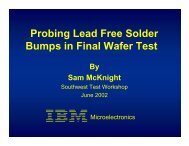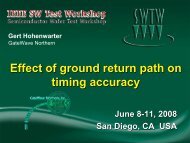Vertical Probing Goes Power
Vertical Probing Goes Power
Vertical Probing Goes Power
Create successful ePaper yourself
Turn your PDF publications into a flip-book with our unique Google optimized e-Paper software.
"<strong>Vertical</strong> <strong>Goes</strong> <strong>Power</strong>":<br />
Multi-Site Wafer <strong>Probing</strong> of<br />
Automotive ICs<br />
Rainer Gaggl, Ph.D.<br />
T.I.P.S. Messtechnik GmbH, Austria<br />
in cooperation with<br />
PROBEST, France<br />
SWTW, June 2004
Overview<br />
The D.U.T.: <strong>Power</strong>/Logic devices for automotive<br />
applications<br />
Cantilever Probes<br />
<strong>Vertical</strong> Probes ?<br />
Thermal Modelling of Interposer, Probes, Bond Pad<br />
Probes Protection / Current Limiting<br />
Example Probecard<br />
Conclusion<br />
-2-
The D.U.T.<br />
Automotive ICs can be characterized by:<br />
Logic circuitry combined with power outputs<br />
Pulsed current on high power outputs: 3-15 A,1 ms,<br />
multiple outputs on one IC<br />
Pincount: approx. 50-200 pins, pad pitch: 100 µm<br />
and more<br />
Sometimes irregular pad layouts with inner lying pads<br />
Wafer testing by now:<br />
Cantilever probecards mostly in single die<br />
Configuration, varying tip diameters to adapt to high<br />
Current demands<br />
-3-
Cantilever Probe Card<br />
Fig. 1: Example of pad and cantilever probes layout for Automotive<br />
IC: 14 different probes types, 2 different tip diameters<br />
Multi-die testing ???<br />
-4-
<strong>Vertical</strong> Probe Card ?<br />
Common idea: vertical buckling beam cards are not<br />
suitable for high power applications, but....<br />
<br />
<br />
Same probe materials used for cantilever and vertical probes...<br />
Contact areas and conducting areas comparable to cantilever<br />
configuration<br />
...so why not ?<br />
Tip diameter 40 µm<br />
Probe diameter 63 µm<br />
Contact area 25 µm<br />
Fig. 2a: typical cantilever probe<br />
Contact area 25 µm<br />
b) vertical probe<br />
-5-
Thermal Modelling (1)<br />
High Current paths: Where is the "fuse"?<br />
Probe Beam ?, Probe Tip ?, Interposer ?<br />
Analytical model of probe and interposer trace: calculate<br />
electrical heating during a short pulse (< 1 ms) to<br />
determine maximum current and pulse duration :<br />
∆T<br />
=<br />
2<br />
j ⋅ ρ<br />
c ⋅ ρ<br />
el<br />
⋅<br />
m<br />
∆T...temperature / K<br />
2<br />
j ... current density / A/m<br />
ρel<br />
... resistivity / Ω ⋅m<br />
2<br />
ρm<br />
... density / kg/m<br />
c ... specific heat / J/(kg ⋅ K)<br />
t ... pulse duration<br />
t<br />
Trace / Probe Heating<br />
for 1,5 A / 1 ms pulse<br />
trace heating [K]<br />
1,76<br />
probe heating [K]<br />
4,4<br />
probe tip heating [K]<br />
177<br />
-6-<br />
Equ. 1: formula<br />
and calculation<br />
results for<br />
electrical probe<br />
and interposer<br />
trace heating
Thermal Modelling (2)<br />
Model of bond pad - electrical heating:<br />
Sourc e Curre nt I 0<br />
Sink Current density j t<br />
Bond pad layer (Al)<br />
Ac tive silic on<br />
(output tra nsistor)<br />
Probe tip,<br />
ra dius r 0<br />
Distribution current density<br />
in contact pad layer j la t<br />
Fig. 3: model of current flow in probe and bond pad<br />
-7-
Thermal Modelling (3)<br />
From analytical model: derive equations for current<br />
densities in bond pad<br />
j<br />
j<br />
D<br />
D<br />
( r)<br />
( r)<br />
=<br />
=<br />
I0<br />
2d<br />
I0<br />
2d<br />
⎛ 1<br />
⎜<br />
⎝ π ⋅ r<br />
⎛ r<br />
⎜<br />
⎝ π ⋅ r<br />
2<br />
0<br />
−<br />
−<br />
r<br />
A<br />
⎞<br />
⎟<br />
⎠<br />
r<br />
A<br />
;<br />
⎞<br />
⎟ ;<br />
⎠<br />
r<br />
r<br />
><br />
<<br />
r<br />
0<br />
r<br />
0<br />
j D<br />
... distribution current density<br />
I0<br />
... source current<br />
d ... bond pad thickness<br />
A ... bond pad area<br />
r0<br />
... probe tip radius<br />
r ... radius from center<br />
Equ. 2: distribution current density in bond pad layer<br />
-8-
Thermal Modelling (4)<br />
Numerical calculation of electrical heating of bond pad<br />
500<br />
bond pad heating<br />
Temperature increase / K<br />
400<br />
300<br />
200<br />
100<br />
0<br />
r 0<br />
0 10 20 30 40 50 60 70<br />
radius from probe tip center / µm<br />
Fig. 4: graph of temperature distribution in bond pad<br />
-9-
Conclusions from Thermal Modelling<br />
Limiting factor for short current pulses is not the probe,<br />
but the heating of the bond pad<br />
<strong>Vertical</strong> probe card design: interposer traces stay cooler<br />
than probes, in case of continuous (DC overload), the<br />
probe will burn, not the interposer<br />
Short overcurrent pulses will not damage probes<br />
initially, but cause the bond pads to melt around the<br />
circumference of the probe tip -> overcurrent protection<br />
needed<br />
-10-
"Experimental" verification<br />
Melting phenomena on high current probe contacts<br />
(cantilever probes)<br />
Fig. 5: molten bond pad due to overcurrent spike, probes still O.K. !<br />
-11-
Probe Current Limiting (1)<br />
"Boundary Conditions":<br />
"Transparent" to Tester<br />
No influence on test results within probing range of<br />
currents<br />
this implies:<br />
Low resistance of clamping circuitry withing nominal<br />
test currents, high resistance only when clamping<br />
Electrically "floating" with respect to tester current<br />
supplies<br />
-12-
Probe Current Limiting (2)<br />
I<br />
I lim<br />
I nom<br />
U<br />
Fig. 6: Electrical characteristics of<br />
"SmartClamp" module<br />
Fig. 7: "SmartClamp" module<br />
-13-
The Test Vehicle (1)<br />
Infineon airbag controller:<br />
8 power outputs (3 A), 16 power pads<br />
dual die configuration<br />
96 A total current on power pads<br />
32 electrically independent clamping circuits<br />
on probecard<br />
172 probes<br />
Cantilever probecard available for comparison<br />
-14-
The Test Vehicle (2)<br />
Fig. 8a: probe head and high<br />
current MLO interposer<br />
Fig. 8b: SmartClamp overcurrent<br />
protection on top of probecard<br />
PCB<br />
-15-
Conclusions<br />
<strong>Vertical</strong> probing for power devices is feasible and shows<br />
at least equal results compared to cantilever probecards<br />
In pulsed high current applications the limiting factor is<br />
not the probe itself but the bond pad area around the<br />
probe impact<br />
Clamping unwanted current spikes by use of<br />
SmartClamp circuitry effectively protects bond pads and<br />
probes from thermal damage<br />
-16-
Acknowledgements<br />
Infineon Technologies Austria AG<br />
S. Zerlauth, R. Letzl, B. Moessler,<br />
F. Reinwald et al.<br />
-17-








